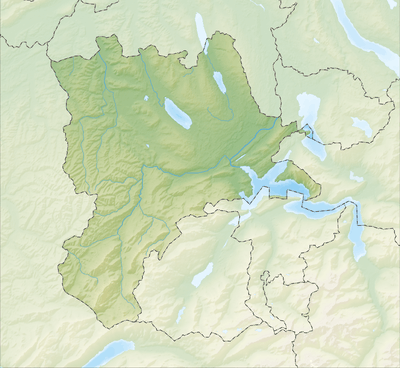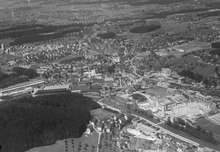Emmen, Switzerland
Emmen is a village and municipality in the district of Hochdorf in the canton of Lucerne in Switzerland. The municipality Emmen consists of the village Emmen, the town Emmenbrücke, and several hamlets.
Emmen | |
|---|---|
 | |
 Coat of arms | |
Location of Emmen 
| |
 Emmen  Emmen | |
| Coordinates: 47°05′N 8°18′E | |
| Country | Switzerland |
| Canton | Lucerne |
| District | Hochdorf |
| Government | |
| • Executive | Gemeinderat with 5 members |
| • Mayor | Gemeindepräsident |
| • Parliament | Einwohnerrat with 40 members |
| Area | |
| • Total | 20.37 km2 (7.86 sq mi) |
| Elevation | 427 m (1,401 ft) |
| Population (2018-12-31)[2] | |
| • Total | 30,926 |
| • Density | 1,500/km2 (3,900/sq mi) |
| Postal code | 6032, 6020 |
| SFOS number | 1024 |
| Localities | Emmen, Emmenbrücke, Rottertswil, Gerliswil, Emmenweid, Waldibrücke, Waltwil, Neuhüsern, |
| Surrounded by | Buchrain, Ebikon, Eschenbach, Littau , Lucerne , Neuenkirch, Rothenburg |
| Website | www Profile (in German), SFSO statistics |
The official language of Emmen is (the Swiss variety of Standard) German, but the main spoken language is the local variant of the Alemannic Swiss German dialect.
History
Emmen is first mentioned in 840 as Emau.[3]
Geography

Emmen has an area of 20.3 km2 (7.8 sq mi). Of this area, 46.6% is used for agricultural purposes, while 18.2% is forested. Of the rest of the land, 33.3% is settled (buildings or roads) and the remainder (1.9%) is non-productive (rivers, glaciers or mountains).[4] In the 1997 land survey, 18.19% of the total land area was forested. Of the agricultural land, 44.69% is used for farming or pastures, while 1.92% is used for orchards or vine crops. Of the settled areas, 14.55% is covered with buildings, 5.7% is industrial, 1.62% is classed as special developments, 1.97% is parks or greenbelts and 9.49% is transportation infrastructure. Of the unproductive areas, 0.25% is unproductive standing water (ponds or lakes), and the other 1.62% is unproductive flowing water (rivers).[5]
The municipality is part of the metropolitan area of Lucerne. It is located at the confluence of the Kleine Emme into the Reuss.
The naturalization law
The municipality of Emmen hit international headlines in 2001 when it announced new naturalization law. While there are some fixed requirements for obtaining Swiss citizenship by naturalization set at the federal level, such as the requirement to live and work for 12 years and speak the local language, Swiss cantons and communities are free to introduce more stringent requirements. Until 2001, naturalization was run by a popularly elected committee. But Emmen decided to have the citizens themselves run the nationalization process, requiring that potential citizens pass a series of tests and public interviews and subjecting citizenship applications to the public vote.
This process prevented many Yugoslavs-Swiss people, the largest ethnic group among citizenship candidates (Emmen has one of the largest of ex-Yugoslav community in Switzerland), from obtaining citizenship. Human rights campaigners said that the public interviews and voting were degrading. In July 2003, the practice was ruled discriminatory and unconstitutional by the Supreme Court.[6] Emmen has since returned to the previous system of naturalization committees.
Population by nationality
Emmen has a population (as of 2007) of 27,205, of which 30.7% are foreign nationals. Over the last 10 years the population has grown at a rate of 2.7%. Most of the population (as of 2000) speaks German (81.6%), with Serbo-Croatian being second most common (5.0%) and Italian being third (3.9%).
| Population by nationality (2000 census) | ||
|---|---|---|
| Nationality | Residents | with dual citizens |
| Switzerland | 18'171 | 19'456 |
| Serbia-Montenegro | 2'332 | 2'408 |
| Italy | 1'299 | 1'811 |
| Croatia | 678 | 741 |
| Bosnia-Herzegowina | 711 | 727 |
| Spain | 500 | 564 |
| Portugal | 449 | 461 |
| Sri Lanka | 286 | 334 |
| Macedonia | 320 | 326 |
| Germany | 212 | 295 |
| Turkey | 152 | 169 |
| Austria | 89 | 123 |
Industry
The main industries are steel production, milk processing and arms manufacture. The biggest employers in these areas are Schmolz + Bickenbach, Emmi AG and Ruag respectively. There is the so-called ´golden triangle´ of the sewage plant, the air force base and the waste incinerating plant. Because of the Emmen Air Force Base and the Emmen Anti Aircraft Unit, many of the inhabitants are directly or indirectly employed by the Air Force.
Emmen has an unemployment rate of 3.62%. As of 2005, there were 257 people employed in the primary economic sector and about 58 businesses involved in this sector. 5260 people are employed in the secondary sector and there are 213 businesses in this sector. 8139 people are employed in the tertiary sector, with 693 businesses in this sector.[4] As of 2000 51.6% of the population of the municipality were employed in some capacity. At the same time, females made up 42.8% of the workforce.[5]
Demographics
In the 2007 election the most popular party was the SVP which received 33.5% of the vote. The next three most popular parties were the CVP (20.8%), the FDP (20.1%) and the SPS (14.2%).
The age distribution in Emmen is; 5,990 people or 21.7% of the population is 0–19 years old. 7,735 people or 28.1% are 20–39 years old, and 9,489 people or 34.4% are 40–64 years old. The senior population distribution is 3,194 people or 11.6% are 65–79 years old, 1,014 or 3.7% are 80–89 years old and 146 people or 0.5% of the population are 90+ years old.[5]
The entire Swiss population is generally well educated. In Emmen about 61.4% of the population (between age 25-64) have completed either non-mandatory upper secondary education or additional higher education (either university or a Fachhochschule).
As of 2000 there are 11,165 households, of which 3,720 households (or about 33.3%) contain only a single individual. 801 or about 7.2% are large households, with at least five members.[5] As of 2000 there were 2,737 inhabited buildings in the municipality, of which 2,339 were built only as housing, and 398 were mixed use buildings. There were 1,131 single family homes, 217 double family homes, and 991 multi-family homes in the municipality. Most homes were either two (868) or three (791) story structures. There were only 133 single story buildings and 547 four or more story buildings.[5]
In the 2000 census the religious membership of Emmen was; 17,253 (64.2%) were Roman Catholic, and 3,416 (12.7%) were Protestant, with an additional 1,327 (4.94%) that were of some other Christian faith. There are 9 individuals (0.03% of the population) who are Jewish. There are 1,848 individuals (6.87% of the population) who are Muslim. Of the rest; there were 228 (0.85%) individuals who belong to another religion, 1,753 (6.52%) who do not belong to any organized religion, 1,051 (3.91%) who did not answer the question.[5]
The historical population is given in the following table:[3]
| year | population |
|---|---|
| 1456 | c. 150 |
| around 1695 | c. 550 |
| 1798 | 1,330 |
| 1850 | 1,764 |
| 1900 | 3,162 |
| 1950 | 11,065 |
| 1970 | 22,040 |
| 2000 | 26,885 |
Transportation
The municipality is thoroughly served by Lucerne's urban transit system VBL, which is part of the fare network passepartout. Two railway lines (S1, RE, S9, S99) lead through the municipality and serves four railway stations: Emmenbrücke, Emmenbrücke Gersag, Rothenburg Dorf, and Waldibrücke. All stops in the municipality are situated within passepartout's innermost zone No. 10, the same as Lucerne.
The military airbase Emmen Air Base (IATA: EML, ICAO: LSME) is part of the municipality.
Sport
FC Emmenbrücke is the village's football club.
Notable people
- Xaver Kurmann (born 1948) a retired Swiss amateur cyclist
- Raphael Koch (born 1990) a footballer, currently plays as a defender for FC Solothurn
- Mario Bühler (born 1992) a football defender playing for FC Vaduz
- Kurt Koch (born 1950) cardinal and President of the Pontifical Council for Promoting Christian Unity. He was the bishop of Basel from 1996 until 2010.
References
- "Arealstatistik Standard - Gemeinden nach 4 Hauptbereichen". Federal Statistical Office. Retrieved 13 January 2019.
- "Ständige Wohnbevölkerung nach Staatsangehörigkeitskategorie Geschlecht und Gemeinde; Provisorische Jahresergebnisse; 2018". Federal Statistical Office. 9 April 2019. Retrieved 11 April 2019.
- Emmen in German, French and Italian in the online Historical Dictionary of Switzerland.
- Swiss Federal Statistical Office Archived January 5, 2016, at the Wayback Machine accessed 18-Aug-2009
- LUSTAT Lucerne Cantonal Statistics Archived November 27, 2011, at the Wayback Machine (in German) accessed 12 August 2009
- Swissinfo (July 9, 2003). "Naturalisation issue taken out of voters' hands". Retrieved 18 August 2009.
External links
| Wikimedia Commons has media related to Emmen. |
- Official Website
- BBC report on the Emmen citizenship tests
- Emmen in German, French and Italian in the online Historical Dictionary of Switzerland.
- Emmenbrücke in German, French and Italian in the online Historical Dictionary of Switzerland.